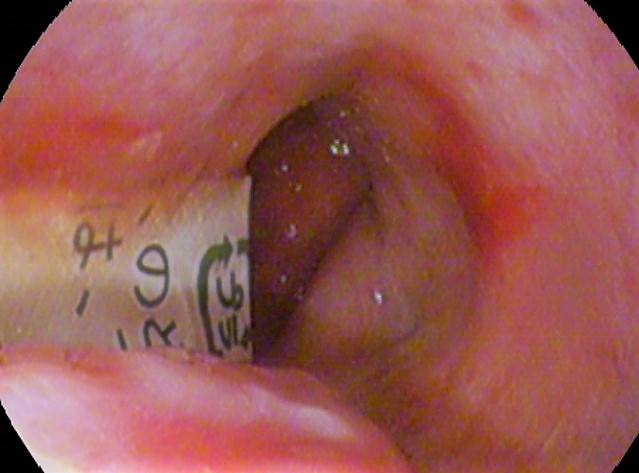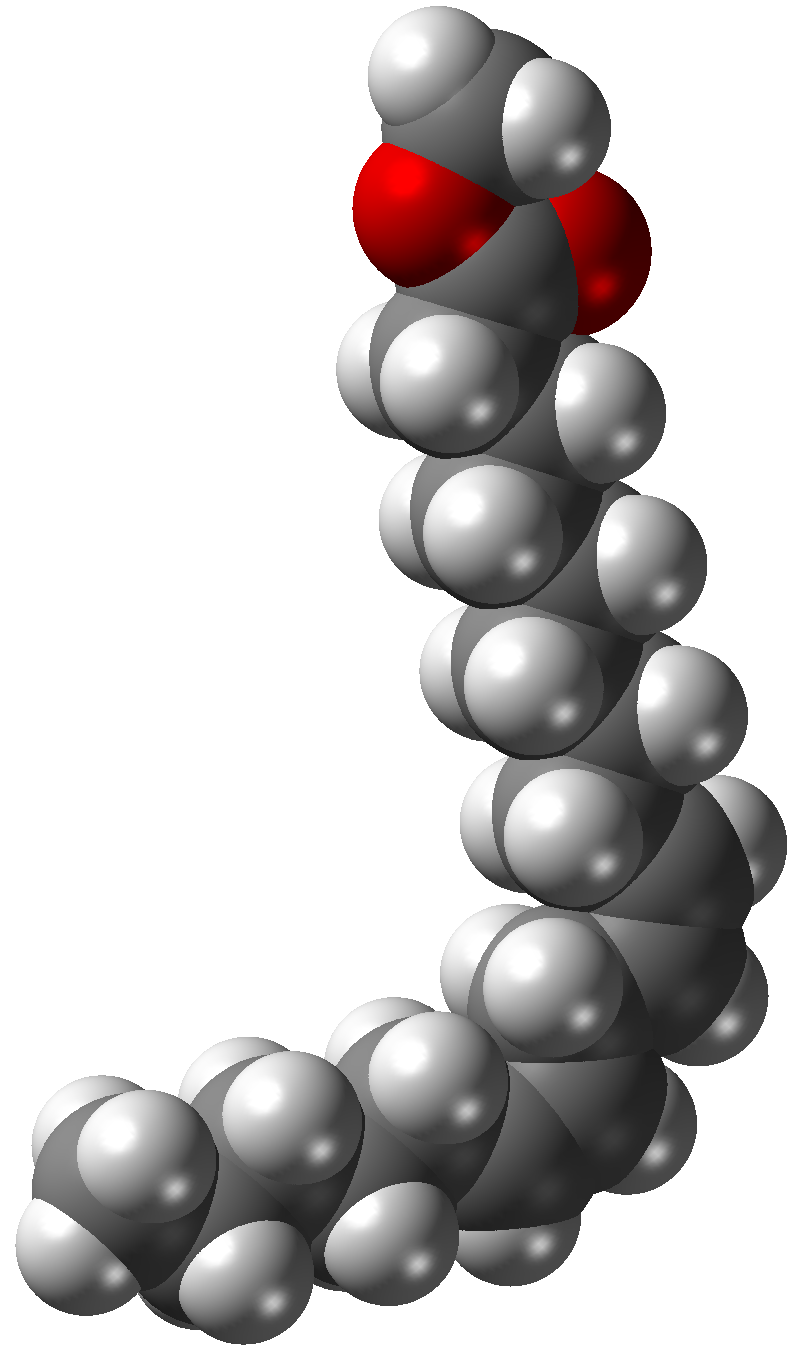|
Ethyl Octanoate
Ethyl octanoate, also known as ethyl caprylate, is a fatty acid ester formed from caprylic acid and ethanol. A colorless liquid at room temperature, it has the semi-developed formula of CH3(CH2)6COOCH2CH3, and is used in food industries as a flavoring and in the perfume industry as a scent additive. It is present in many fruits and alcoholic beverages, and has a strong odor of fruit and flowers. It is used in the creation of synthetic fruity scents. Synthesis Ethyl octanoate can be synthesized from caprylic acid and ethanol via a classic Fischer–Speier esterification. CH3(CH2)6COOH + CH3CH2OH CH3(CH2)6COOCH2CH3 + H2O Equilibrium can be shifted towards the right side of the equation through removal of water. Uses Ethyl octanoate does not see widespread use due to the greater availability of reasonably similar esters such as ethyl acetate. However, there are certain applications where it fills a niche. Ethyl octanoate has a strong odor of fruit and flowers and a taste of ap ... [...More Info...] [...Related Items...] OR: [Wikipedia] [Google] [Baidu] |
Ingestion
Ingestion is the consumption of a substance by an organism. In animals, it normally is accomplished by taking in a substance through the mouth into the gastrointestinal tract, such as through eating or drinking. In single-celled organisms ingestion takes place by absorbing a substance through the cell membrane. Besides nutritional items, substances that may be ingested include medication (where ingestion is termed oral administration), recreational drugs, and substances considered inedible, such as foreign bodies or excrement. Ingestion is a common route taken by pathogenic organisms and poisons entering the body. Ingestion can also refer to a mechanism picking up something and making it enter an internal hollow of that mechanism, e.g. "''a grille was fitted to prevent the pump from ingesting driftwood''". Pathogens Some pathogens are transmitted via ingestion, including viruses, bacteria, and parasites. Most commonly, this takes place via the faecal-oral route. An interm ... [...More Info...] [...Related Items...] OR: [Wikipedia] [Google] [Baidu] |
Fatty Acid Ester
Fatty acid esters (FAEs) are a type of ester that result from the combination of a fatty acid with an alcohol. When the alcohol component is glycerol, the fatty acid esters produced can be monoglycerides, diglycerides, or triglycerides. Dietary fats are chemically triglycerides. Esters of fatty acids are colorless, although degraded samples are sometime appear to be yellow or even brown. The triglycerides are powders, flakes, coarse powders, or granular or waxy lumps, oils or liquids. They are almost odorless. Biodiesels are typically fatty acid esters made by the transesterification of vegetable fats and oils. In this process the glycerol component is replaced with a different alcohol. The most commonly used alcohol is methanol, producing fatty acid methyl esters (FAME). When ethanol is used fatty acid ethyl esters (FAEE) are created. Other alcohols used for the production of biodiesel include butanol and isopropanol. Fatty acid ethyl esters are biomarkers for the consumption o ... [...More Info...] [...Related Items...] OR: [Wikipedia] [Google] [Baidu] |
Caprylic Acid
Caprylic acid (), also known under the systematic name octanoic acid or C8 Acid, is a saturated fatty acid, medium-chain fatty acid (MCFA). It has the structural formula , and is a colorless oily liquid that is minimally soluble in water with a slightly unpleasant rancid-like smell and taste. Salts and esters of octanoic acid are known as octanoates or caprylates. It is a common industrial chemical, which is produced by oxidation of the C8 aldehyde. Its compounds are found naturally in the milk of various mammals and as a minor constituent of coconut oil and palm kernel oil. Two other acids are named after goats via the Latin word '' capra'': caproic acid (C6) and capric acid (C10). Together, these three fatty acids comprise 15% of the fatty acids in goat milk fat. Uses Caprylic acid is used commercially in the production of esters used in perfumery and also in the manufacture of dyes. Caprylic acid is an antimicrobial pesticide used as a food contact surface sanitizer in c ... [...More Info...] [...Related Items...] OR: [Wikipedia] [Google] [Baidu] |
Ethanol
Ethanol (abbr. EtOH; also called ethyl alcohol, grain alcohol, drinking alcohol, or simply alcohol) is an organic compound. It is an alcohol with the chemical formula . Its formula can be also written as or (an ethyl group linked to a hydroxyl group). Ethanol is a volatile, flammable, colorless liquid with a characteristic wine-like odor and pungent taste. It is a psychoactive recreational drug, the active ingredient in alcoholic drinks. Ethanol is naturally produced by the fermentation process of sugars by yeasts or via petrochemical processes such as ethylene hydration. It has medical applications as an antiseptic and disinfectant. It is used as a chemical solvent and in the synthesis of organic compounds, and as a fuel source. Ethanol also can be dehydrated to make ethylene, an important chemical feedstock. As of 2006, world production of ethanol was , coming mostly from Brazil and the U.S. Etymology ''Ethanol'' is the systematic name defined by the Interna ... [...More Info...] [...Related Items...] OR: [Wikipedia] [Google] [Baidu] |
Fischer–Speier Esterification
Fischer esterification or Fischer–Speier esterification is a special type of esterification by refluxing a carboxylic acid and an alcohol in the presence of an acid catalyst. The reaction was first described by Emil Fischer and Arthur Speier in 1895. Most carboxylic acids are suitable for the reaction, but the alcohol should generally be primary or secondary. Tertiary alcohols are prone to elimination. Contrary to common misconception found in organic chemistry textbooks, phenols can also be esterified to give good to near quantitative yield of products. Commonly used catalysts for a Fischer esterification include sulfuric acid, p-toluenesulfonic acid, and Lewis acids such as scandium(III) triflate. For more valuable or sensitive substrates (for example, biomaterials) other, milder procedures such as Steglich esterification are used. The reaction is often carried out without a solvent (particularly when a large reagent excess of alcohol is used) or in a non-polar solvent (e.g. ... [...More Info...] [...Related Items...] OR: [Wikipedia] [Google] [Baidu] |
Ethyl Acetate
Ethyl acetate ( systematically ethyl ethanoate, commonly abbreviated EtOAc, ETAC or EA) is the organic compound with the formula , simplified to . This colorless liquid has a characteristic sweet smell (similar to pear drops) and is used in glues, nail polish removers, and in the decaffeination process of tea and coffee. Ethyl acetate is the ester of ethanol and acetic acid; it is manufactured on a large scale for use as a solvent. Production and synthesis Ethyl acetate was first synthesized by the Count de Lauraguais in 1759 by distilling a mixture of ethanol and acetic acid. In 2004, an estimated 1.3 million tonnes were produced worldwide. The combined annual production in 1985 of Japan, North America, and Europe was about 400,000 tonnes. The global ethyl acetate market was valued at $3.3 billion in 2018. Ethyl acetate is synthesized in industry mainly via the classic Fischer esterification reaction of ethanol and acetic acid. This mixture converts to the ester in ab ... [...More Info...] [...Related Items...] OR: [Wikipedia] [Google] [Baidu] |
Wine
Wine is an alcoholic drink typically made from fermented grapes. Yeast consumes the sugar in the grapes and converts it to ethanol and carbon dioxide, releasing heat in the process. Different varieties of grapes and strains of yeasts are major factors in different styles of wine. These differences result from the complex interactions between the biochemical development of the grape, the reactions involved in fermentation, the grape's growing environment ( terroir), and the wine production process. Many countries enact legal appellations intended to define styles and qualities of wine. These typically restrict the geographical origin and permitted varieties of grapes, as well as other aspects of wine production. Wines not made from grapes involve fermentation of other crops including rice wine and other fruit wines such as plum, cherry, pomegranate, currant and elderberry. Wine has been produced for thousands of years. The earliest evidence of wine is from the Cau ... [...More Info...] [...Related Items...] OR: [Wikipedia] [Google] [Baidu] |
Flammability Limit
Mixtures of dispersed combustible materials (such as gaseous or vaporised fuels, and some dusts) and oxygen in the air will burn only if the fuel concentration lies within well-defined lower and upper bounds determined experimentally, referred to as flammability limits or explosive limits. Combustion can range in violence from deflagration through detonation. Limits vary with temperature and pressure, but are normally expressed in terms of volume percentage at 25 °C and atmospheric pressure. These limits are relevant both in producing and optimising explosion or combustion, as in an engine, or to preventing it, as in uncontrolled explosions of build-ups of combustible gas or dust. Attaining the best combustible or explosive mixture of a fuel and air (the stoichiometric proportion) is important in internal combustion engines such as gasoline or diesel engines. The standard reference work is still that elaborated by Michael George Zabetakis, a fire safety engineering spe ... [...More Info...] [...Related Items...] OR: [Wikipedia] [Google] [Baidu] |
Octanoate Esters
Caprylic acid (), also known under the systematic name octanoic acid or C8 Acid, is a saturated fatty acid, medium-chain fatty acid (MCFA). It has the structural formula , and is a colorless oily liquid that is minimally soluble in water with a slightly unpleasant rancid-like smell and taste. Salts and esters of octanoic acid are known as octanoates or caprylates. It is a common industrial chemical, which is produced by oxidation of the C8 aldehyde. Its compounds are found naturally in the milk of various mammals and as a minor constituent of coconut oil and palm kernel oil. Two other acids are named after goats via the Latin word ''capra'': caproic acid (C6) and capric acid (C10). Together, these three fatty acids comprise 15% of the fatty acids in goat milk fat. Uses Caprylic acid is used commercially in the production of esters used in perfumery and also in the manufacture of dyes. Caprylic acid is an antimicrobial pesticide used as a food contact surface sanitizer in commer ... [...More Info...] [...Related Items...] OR: [Wikipedia] [Google] [Baidu] |




